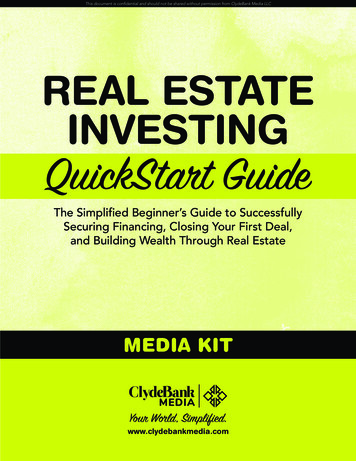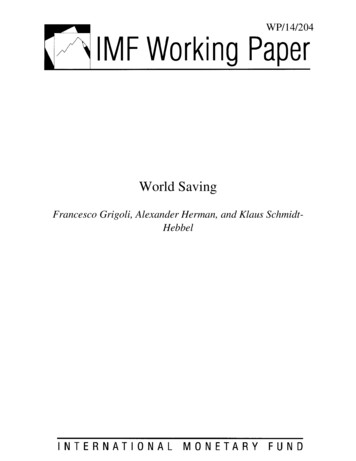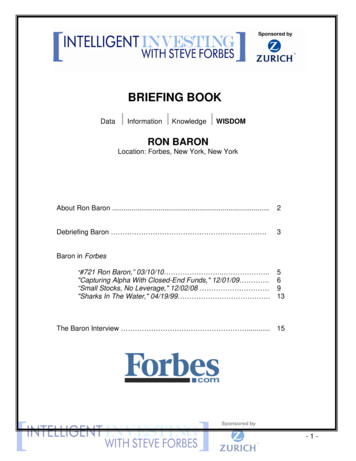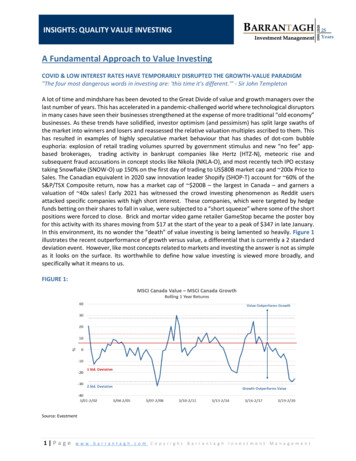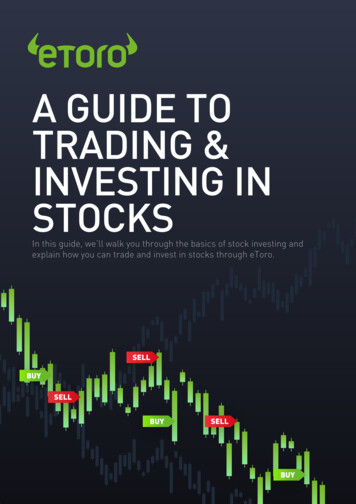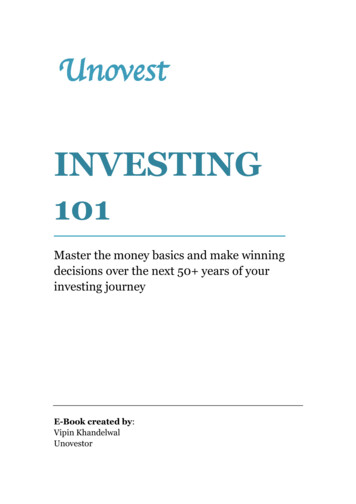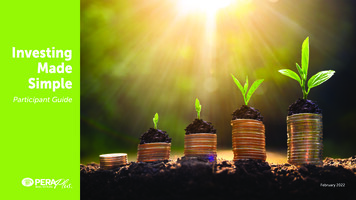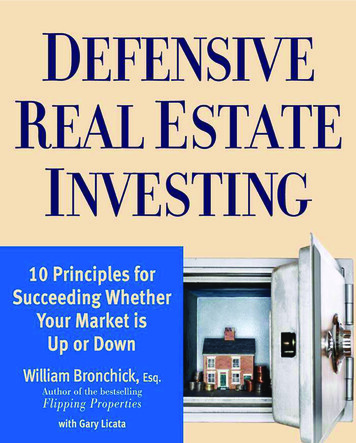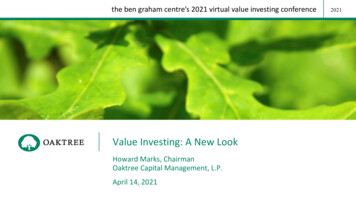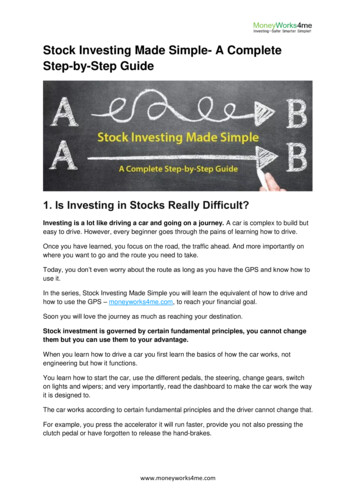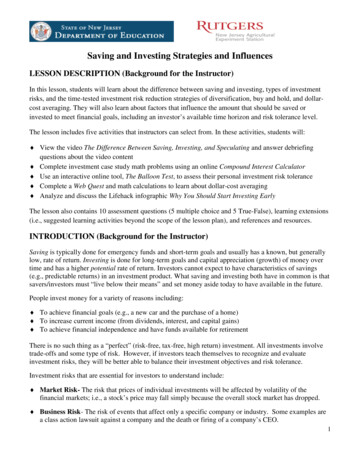
Transcription
Saving and Investing Strategies and InfluencesLESSON DESCRIPTION (Background for the Instructor)In this lesson, students will learn about the difference between saving and investing, types of investmentrisks, and the time-tested investment risk reduction strategies of diversification, buy and hold, and dollarcost averaging. They will also learn about factors that influence the amount that should be saved orinvested to meet financial goals, including an investor’s available time horizon and risk tolerance level.The lesson includes five activities that instructors can select from. In these activities, students will: View the video The Difference Between Saving, Investing, and Speculating and answer debriefingquestions about the video content Complete investment case study math problems using an online Compound Interest Calculator Use an interactive online tool, The Balloon Test, to assess their personal investment risk tolerance Complete a Web Quest and math calculations to learn about dollar-cost averaging Analyze and discuss the Lifehack infographic Why You Should Start Investing EarlyThe lesson also contains 10 assessment questions (5 multiple choice and 5 True-False), learning extensions(i.e., suggested learning activities beyond the scope of the lesson plan), and references and resources.INTRODUCTION (Background for the Instructor)Saving is typically done for emergency funds and short-term goals and usually has a known, but generallylow, rate of return. Investing is done for long-term goals and capital appreciation (growth) of money overtime and has a higher potential rate of return. Investors cannot expect to have characteristics of savings(e.g., predictable returns) in an investment product. What saving and investing both have in common is thatsavers/investors must “live below their means” and set money aside today to have available in the future.People invest money for a variety of reasons including: To achieve financial goals (e.g., a new car and the purchase of a home) To increase current income (from dividends, interest, and capital gains) To achieve financial independence and have funds available for retirementThere is no such thing as a “perfect” (risk-free, tax-free, high return) investment. All investments involvetrade-offs and some type of risk. However, if investors teach themselves to recognize and evaluateinvestment risks, they will be better able to balance their investment objectives and risk tolerance.Investment risks that are essential for investors to understand include: Market Risk- The risk that prices of individual investments will be affected by volatility of thefinancial markets; i.e., a stock’s price may fall simply because the overall stock market has dropped. Business Risk- The risk of events that affect only a specific company or industry. Some examples area class action lawsuit against a company and the death or firing of a company’s CEO.1
Interest Rate Risk- This risk affects fixed-income securities (e.g., bonds and bond funds). There is aninverse relationship between bond prices and interest rates. When interest rates rise, bond prices fall. Inflation Risk- The risk of a loss of purchasing power, which can occur if the rate of inflation (asmeasured by the Consumer Price Index or CPI) is higher than the rate of return on an investment. Reinvestment Risk- The risk of having to reinvest existing funds and earn a lower return than whatwas previously earned (due to decreasing market interest rates), resulting in a decline in income.There are two basic ways to invest money: Investors can loan it to pay for a company’s or a governmententity’s (e.g., state, city) operations OR they can own an investment outright: Loanership- When investors loan money to a company or government entity, they receive incomebased upon a set interest rate for a set period of time. The issuer of the investment promises to pay backthe original principal plus interest. Loanership investments include bonds, bond mutual funds, moneymarket accounts and mutual funds, Treasury bills, bonds and notes, and certificates of deposit (CDs). Ownership- When investors own an investment, they purchase all or part of it (e.g., apartment buildingor share of stock). The value of ownership assets will fluctuate with market conditions, potentiallyproviding a higher return than investors would receive from loaning money. Ownership investmentsinclude stocks, stock mutual funds, real estate, commodities, collectibles, and precious metals.Generally, investors incur more risk (of loss of principal), but have higher potential returns, with ownershipinvestments. Many people struggle with the risk vs. reward tradeoff when they begin investing, however.They may choose investments that are so conservative that their money does not grow after taxes andinflation. Several strategies can reduce investment risk and increase the possibility of higher growth: Diversification- Selecting a variety of investments (e.g., stocks, bonds, and cash assets) and a varietyof securities within each type of investment, such as stock issued by a variety of companies. Buy and Hold- Investing for a long period of time (at least five years), regardless of market volatility,and ignoring temporary ups and downs in the stock market. Dollar-Cost Averaging- Making regular investment deposits at regular time periods (e.g., 100 permonth). The set amount will buy more shares when prices are down and fewer when prices are high.Three key factors influence how much money should be saved or invested to meet financial goals: Time- Young adults can invest less per month than older adults to reach a specific goal (e.g., 1 millionfor retirement) because they have many years ahead of them to save and invest. For every decade ofdelay, the amount needed to set aside to reach a financial goal approximately triples. Rate of Return- The higher an investment’s average annual return (e.g., 6% vs. 4%), the less moneyinvestors have to personally deposit because compound interest is working harder on their behalf. Risk Tolerance- This is an investor’s capacity to handle the uncertainty that accompanies the selectionof specific investment products such as stocks. Risk tolerance has also been referred to as the “sleep atnight factor,” as in “how much investment risk can you withstand and still be able to sleep at night?”Not all factors related to investment risk tolerance are financial ones, such as income and net worth. Aninvestor’s knowledge about investing, previous investment experiences, and attitudes about risk-taking ingeneral can also be influences. Risk tolerance levels associated with investments may also be associatedwith other types of risk-taking behaviors in life such as fast driving and participation in extreme sports.2
Rutgers Cooperative Extension has an online Investment Risk Tolerance Quiz. The quiz includes 13questions and provides users with feedback about their capacity to handle investment risk. It also collectsdata for research. The higher the total score, the higher someone’s investment risk tolerance. Quizquestions are based on both thoughts about risk in hypothetical situations and current investing behavior.Ideally, an investors’ risk tolerance level should remain about the same during bull (rising) and bear(falling) markets. However, this is often not the case. What often happens, instead, is that investors’ risktolerance levels are greatly influenced by the current direction of benchmark market indexes (e.g., DJIA).Asset allocation is the process of dividing a person’s portfolio (the sum total of their investments, whateverthe amount), percentage wise, into different asset classes. For example, 50% stock, 30% bonds, and 20%cash equivalent assets. Different investments are then purchased within each asset class. Aggressiveinvestors will have more stock in their portfolio than moderate investors and moderate investors will havemore stock in their portfolio than conservative investors.A frequently cited guideline is “110 – your age” as the suggested percentage of portfolio assets to put instocks. For example, 110 – 30 (age) an 80% stock allocation. At age 40, the stock allocation woulddecrease to 70% (110-40). This guideline corresponds with recommendations to gradually decrease thepercentage of stocks in a portfolio as investors get older (rationale: to shift to more income-orientedinvestments and because there are fewer years of life left to recover from stock market downturns).Note: Additional information about basic investing concepts and investment products can be found in theNew Jersey Department of Education Standard 9.1.12.D.3 lesson plan #6, Investing For Your Future.OBJECTIVESStudents will be able to: Describe differences between strategies used to save and invest money. Calculate the amount of savings required to achieve financial goals in case study math problems. Compare the amount accumulated on savings and investments at various rates of return. Describe factors that affect the amount of savings/investments needed to achieve financial goals. Assess and describe their personal investment risk tolerance. Appreciate the awesome power of compound interest in growing savings and investments over time.NEW JERSEY PERSONAL FINANCIAL LITERACY STANDARD Standard 9.1.12.B.2: Compare strategies for saving and investing and the factors that influence howmuch should be saved or invested to meet financial goals.See LFAQ.htm#gradcredit er/91.pdf for information about Standard 9.1TIME REQUIRED45 to 180 minutes (depending upon student progress and content depth and number of activities used)3
MATERIALS YouTube Video (2.48): The Difference Between Saving, Investing, and Speculating:https://www.youtube.com/watch?v blnbxbftme0 and video debriefing questions Compound Interest Calculator (U.S. Securities and Exchange erestcalculator Compound Interest Calculator Case Study Problems activity handout The Balloon Test [investment risk tolerance assessment tool] (Barclays) and activity est Dollar-Cost Averaging Web Quest and Math Calculation activity handout Why You Should Start Investing as Early as Possible Infographic should-start-investing-early-possible-infographic Saving and Investing Quiz (ASSESSMENT)Teachers are encouraged to use as many of the student learning activities as time permits to provide afuller understanding of saving and investing strategies and influences. The activities can also be used forextra credit assignments, homework, or after-school activities.PROCEDURE1. Ask students if they have any personal experience with investing. For example, have they received anyinvestments (e.g., stock shares) as a gift or are they aware of investments owned by family members?Answers will likely vary. Students may or may not have any personal or family experience. In thesecond case, ask if they are aware of any famous investors (e.g., Warren Buffet). Explain that mostfamous and successful investors use systematic strategies that they stick to over long periods of time.2. Activity 1: Show the video The Difference Between Saving, Investing, and Speculating:https://www.youtube.com/watch?v blnbxbftme0 and debrief the following questions (based on videocontent) with students:What does the word “saving” mean?Saving is the process of setting money aside as a reserve for emergencies or to make a short-termpurchase (less than three years in the future).What are the most important advantages of savings products?Safety of principal (the amount of money that is put into savings) and no fluctuation in account value.What are three types of savings products mentioned in the video?Savings accounts, money market accounts, and certificates of deposit, which are described below: Savings Accounts- High flexibility (e.g., low required minimum balances and no or low requiredwithdrawal amounts) and low interest rates Money Market Accounts- Less flexibility (e.g., higher required minimums and/or withdrawalamounts) and slightly higher interest rates than savings accounts (typically) Certificates of Deposit (CDs)- Time deposit commitments (e.g., 6 months) and higher interest4
What is the biggest disadvantage of savings products?Slow growth of principal due to a low rate of return on deposited funds.What does the word “investing” mean?Investing is a long-term process of setting aside money with the expectation of earning more than therate of inflation through the growth of principal over time.What are the most important advantages of investment products?Potential for higher long-term returns than savings products and potential to outperform inflation.What are two key disadvantages of investment products?Risk of loss of principal and volatility (i.e., the value of most investments bounces up and down).What does the word “speculating” mean?Putting money at risk with the hope of earning a high return in a short period of time.Using the words saving, investing, and speculating Which word defines protecting your money? Saving Which word defines growing your money? Investing Which word defines gambling with your money? Speculating3. Activity 2: Direct students to the Compound Interest Calculator on the U.S. Securities and ExchangeCommission website: tor. Ask them to work together in small groups to analyze the casestudy below. Then debrief the activity and the take-away messages from the calculator results.The calculator has fields or a drop-down menu (step 4) for four simple steps: 1. Initial investmentamount (if any), 2. Amount added to the principal and length of time, in years, that savings deposits aremade, 3. Interest rate (estimated annual rate), and 4. Compounding frequency (annually, semi-annually,monthly, and daily). Once these fields are completed, users can click “Calculate” for results.Jon Bentley is 22 and plans to retire at 67. His uncle gave him a 1,000 gift to start a retirementfund and Jon used it to start a Roth IRA. Jon also joined the 401(k) plan at work. If Jon earns a6% average return on both accounts (the Roth IRA and his 401(k) at work), compoundedannually, how much would he have in the Roth IRA account at retirement?John would have 13,764.61 in 45 years.How much would Jon have if he added 50 monthly to the 1,000 lump sum from his uncle?Jon would have 141,410.72 in 45 years.How much would Jon have if he added 100 monthly to the 1,000 lump sum from his uncle?Jon would have 269,056 in 45 years.How much would Jon have if he added 200 monthly to the 1,000 lump sum from his uncle?Jon would have 524,249.04 in 45 years.5
How much would Jon have if he added 200 monthly to the 1,000 lump sum from his uncle andhe received a 50% employer match?Jon would have 779,641.26 in 45 years. There would be a 300 monthly deposit: 200 100 match.How much would Jon’s 32-year old co-worker, Sara, have if she started to invest 200 monthlyfor retirement with a 50% employer match until age 67?Sara would have 401,165.21 in 35 years.How much would Jon’s 42-year old co-worker, Steve, have if he started to invest 200 monthlyfor retirement with a 50% employer match until age 67?Steve would have 197,512.24 in 25 years.How much would Jon’s 52-year old co-worker, Sandra, have if she started to invest 200 monthlyfor retirement with a 50% employer match until age 67?Sandra would have 83,793.49 in 15 years.Switch to the Savings Goal Calculator. With the 1,000 gift from his uncle, 6% growth over 45years, and annual compounding, how much must Jon invest to have 1 million at retirement?If Jon invests 386.32 every month (including employer match) over the next 45 years, he will have 1,000,000 in savings at age 67. See the graphic image of the Savings Goal Calculator below.Debrief the activity by having students discuss what they found out investing and compound interest.Answers will likely vary and may include the following: Growth on regular savings amounts is very impressive over time. Earnings on regular deposits over time are more impressive than earnings on a single lump sum. Employer matching (50 cents on the dollar, in this case) is a very valuable employee benefit to havebecause not all of the savings has to come from a worker’s paycheck. The larger Jon’s regular monthly savings amount, the more impressive his total savings was. It is very costly to delay retirement savings; for example, Steve has less than half of what Sara has. Saving less than 100 a week in one’s early 20s can result in 1 million of savings at age 67.6
4. Activity 3: Distribute The Balloon Test activity handout and direct students to The Balloon Testinteractive activity: inance/your-attitude-torisk/the-balloon-test. Tell students to decide when (i.e., for how long?) to keep pumping the blueballoon to earn 50 points for each pump. This is like earning money on an investment. They also needto decide when to stop pumping to collect and bank points, ideally before a balloon bursts. This is likeselling an investment and making a profit. At any time, balloons can burst, however, and make a loudpopping noise. This is like losing money on an investment when stock or bond prices decrease.Have students play The Balloon Test for five rounds. This is like investing for the long term whereinvestment results can vary. Have students compare their total points to the baseline data by clicking“Compare with Others” and answer the following questions: What was the highest and lowest number of points that you received on five rounds of play?Each student’s results will vary. Their total point values could vary from 0 to over 1,000 per rounddepending on how they played the game and the randomness of the balloon popping simulations. How did you feel when your first balloon burst?Students will likely express disappointment or anger, especially when a balloon bursts before theyhave a chance to collect and bank any points. Investors often have the same types of feelings. Did having a bubble burst change your behavior on subsequent rounds of play (i.e., futureinvestment decisions)?Students may express a tendency to not pump a balloon as frequently after a few “pops.” Did having a “good run” without balloons popping change your behavior on subsequentrounds of play?Students may express a tendency to pump a balloon more frequently after it doesn’t burst quickly. How would you assess your risk tolerance as an investor?Student answers will vary. Discuss differences, if any, by gender or grade level and ask students todescribe similarities between decisions made on The Balloon Test activity and real life investing. What did The Balloon Test activity teach you about investing in stocks?Answers will vary but students should indicate that stock market performance is variable (i.e., bothlosses and gains) and unpredictable, just like balloon popping patterns vary from round to round.7
5. Activity 4: Distribute the Dollar-Cost Averaging Web Quest and Math Calculation activity handoutand ask students to find information about dollar-cost averaging and to write a simple definition of thisinvestment technique. Then ask them to complete the table and questions about the mutual fund dollarcost averaging case example below. Note: Information to be completed by students is shown in red.MonthRegular InvestmentPrice Per ShareShares Acquired1 100 10.0010.002 100 7.5013.333 100 5.0020.004 100 7.5013.335 100 10.0010.00TOTAL 50066.66How much money was invested? 500How many shares were purchased? 66.66What was the average cost per share? 7.50 ( 500 66.66 7.50)How much are the investor’s shares worth on the day of the month 5 purchase? 666.60 (66.66shares purchased x 10 per share)What is the take-away message from this table? Investing happens on a regular schedule. Investorsbuy shares with a fixed monthly deposit ( 100). They buy more shares when share prices are low (e.g., 5.00 per share) and fewer shares when share prices are high (e.g., 10.00 per share). The average costper share is calculated by dividing the amount invested (e.g., 500) by the number of shares purchased(e.g., 66.66). Dollar-cost averaging lowers the average cost per share over time, resulting in anincreased opportunity for investors to make a profit (capital gain). It also reduces the emotionsassociated with investing because share purchases are made regardless of stock market conditions.6. Activity 5: Direct students to the Why You Should Start Investing as Early as Possible infographic art-investing-early-possible-infographic. Ask themto describe its take-away message. Debrief students’ responses with the entire class.Student answers will vary but should center on the fact that David has 151,975 more than Bruce atage 65 even though David only saved for eight years from age 19 to age 26 (total of 16,000) vs. Brucesaving for 38 years from age 27 to age 65 (total of 76,000). The reason is that David made hissavings deposits at a young age and his early deposits earned compound interest for an extra decade.8
CLOSUREAsk students if they have any remaining questions about investing terminology and strategies. Remindthem that investment risk tolerance is a personal preference and there is no “right” risk tolerance level.Conservative investors will need to save more money out-of-pocket than more aggressive investors (i.e.,investors with more stock in their portfolio), however, because their money will likely grow more slowly.GLOSSARYAsset Allocation- The placement of a certain amount (percentage) of one’s investment capital withindifferent types of asset classes; e.g., 50% stock, 30% bonds, and 20% cash equivalent assets.Bond- A debt security (IOU) issued by a government or corporation that pays periodic interest to investors.Buy and Hold- A strategy of purchasing securities believed to be of high quality and keeping them for anumber of years.Capital Gain- Profit made when an investor sells an investment for more than the amount paid to buy it.Certificate of Deposit (CD)- A fixed amount of money deposited with a financial institution for aspecified amount of time (e.g., 6 month and 12 month CDs) to earn interest.Collectible- A tangible item (e.g., coins, stamps, art, and collector cars) purchased as an investment.Compound Interest- Earning interest on previously-earned interest to build investment wealth over time.Diversification- The process of reducing investment risk by selecting a variety of investments.Dollar-Cost Averaging- Investing a set amount at set time intervals; e.g., 50 on the first of every month.Investing- Setting aside money to grow your net worth and to achieve long-term financial goals.Loanership Investment- Type of investment where investors loan money to a company or governmententity and receive income (interest) for a set time (e.g., corporate, U.S. Treasury, and municipal bonds).Ownership Investment- Type of investment where investors own all or part of something and the assetvalue fluctuates with market conditions (e.g., common stock, stock mutual funds, and real estate).Principal- The original amount of money that someone invests (e.g., stocks) or borrows (e.g. a mortgage).Risk- The chance of loss of investment principal; e.g., a high-risk investment has a high chance of loss.Risk Tolerance- Personal feelings of individuals about how much investment risk they want to take.Saving- Setting aside money for emergencies, upcoming expenses, and short-term financial goals.Speculating-The act of investing in securities that have a high risk of loss with the expectation of a largegain (profit) in a short period of time.Stock- Unit of ownership of a corporation represented by shares owned by individual investors.9
LEARNING EXTENSIONSIf time permits, the following activities can be used to extend the depth of this lesson: Use the learning activities and/or learning extension activities found in the Investing For Your Futurelesson plan: n-12-Investing-for-Your-Future.pdf. Ask students to check with their parents or other family members to see if they own any investmentsand, if so, what types of securities are owned. Invite a local certified financial planner as a guest speaker to discuss investment terminology,products, and strategies and share stories about successful and unsuccessful investors. Have students take the online Rutgers Cooperative Extension Investment Risk Tolerance Quiz anddebrief the meaning of the results: http://njaes.rutgers.edu/money/riskquiz/ Refer students to the Financial Planning and Investing Glossary for additional terminology ry.asp. Have students view and debrief additional YouTube videos about investing:Dollar Cost Averaging, Explained (Paddy Hirsch): https://www.youtube.com/watch?v ZFEnwg54Zj4Investing Basics: Retirement (Investools): https://www.youtube.com/watch?v LB4k-uL4nwMSaving vs. Investing (Zions TV): https://www.youtube.com/watch?v SoHgDXLj9hY&t 35sThe Power of Diversification (E*Trade): https://www.youtube.com/watch?v pNO3Rmmezc0&t 29sTime Value of Money (Zions TV): https://www.youtube.com/watch?v 0etEItEINZw Have students try out one or more of the following investment calculators listed below. Teachers maywant to create simple case studies with personal finance data that can be entered into the calculator.Investment Calculator (Bankrate): estment-goalcalculator.aspxInvestment Calculator (American anning/tools/investment-calculator.htmInvestment Calculator: Investing Now vs. Later gecenter/Public/Calculators/Investment Have students write a summary of what they learned about investments for the school newspaper. Have students analyze and discuss information contained within the following infographics:4 Investment Strategies to Grow Wealth Infographic (Motif estment-strategies-to-grow-wealthInvesting by Age Infographic (Nerd infographics/infographic-investing-age/Rules of the Game: How Investing Works Infographic [Compares Investing to Basketball With wordsand Pictures] (Northern Trust): start-investing-rulesof-the-game10
ASSESSMENT: Saving and Investing QuizInstructors are encouraged to use the questions below for content review or as a pre-and/or post-test todetermine gains in student knowledge about saving and investing after teaching this lesson.Correct answers to the multiple choice and True-False questions are shown in boldface type.Multiple Choice Questions1. Buying a specific amount of stock or mutual fund shares at regular time intervals is calleda. Market timingb. Asset allocationc. Dollar-cost averagingd. Speculating2. The process of owning many stocks in a variety of industries to reduce investment risk is calleda. Asset allocationb. Speculatingc. Dollar-cost averagingd. Diversification3. What of the following is not an ownership asset?a. Real estateb. U.S. Treasury bondc. Stock index fundd. Shares of Apple and Google stock4. Using a frequently cited guideline, what percentage of a 35 year old’s investments should be in stock?a. 65%b. 70%c. 75%d. 80%5. What investment strategy do investors typically follow as they get older and approach retirement?a. They choose less risky investmentsb. They choose more risky investmentsc. Their investment strategy does not changed. They choose speculative investments to try to make a large profit quicklyTrue-False Questions1. Bonds are an example of a loanership investment (TRUE: When investors buy bonds, they arelending money to a city, county, state, or the federal government or a for-profit corporation for aperiod of time, such as 10 or 30 years. During this time, bond investors receive interest from thebond issuer. When the bond matures, investors receive back their principal)11
2. The potential return on an investment is typically related to the amount of risk than an investor assumes(TRUE: The potential return on investments typically rises with the level of risk that investorsassume. When an investment has a low level of risk and uncertainty, it typically has a lowpotential return and when an investment has a high level of risk and uncertainty, it typically has ahigh potential return. This is often referred to as the risk-return tradeoff)3. The minimum time to invest using the “buy and hold” strategy is one year (FALSE: “Buy and hold” isa passive investment strategy where high quality stocks are held for a long period of timeregardless of stock market fluctuations. The minimum recommended holding period for thisstrategy is typically five years. By holding investments for more than a year, investors qualify forfavorable long-term capital gain income tax rates vs. higher tax rates for short-term investments)4. For every decade that people delay investing, the amount that they need to save to reach a financial goalapproximately doubles (FALSE: The amount that must be invested a decade later (e.g., by a 35year old vs. a 25 year old) is about three times higher. People who delay investing by ten years losea decade of compound interest and compound interest is not retroactive)5. Investment products are more likely to outpace the rate of inflation
2 Interest Rate Risk- This risk affects fixed-income securities (e.g., bonds and bond funds).There is an inverse relationship between bond prices and interest rates. When interest rates rise, bond prices fall. Inflation Risk- The risk of a loss of purchasing power, which can occur if the rate of inflation (as measured by the Consumer Price Index or CPI) is higher than the rate of .
